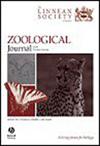The evolution of novel mouthpart interlocking mechanisms in ants (Hymenoptera: Formicidae)
IF 2.8
2区 生物学
Q1 ZOOLOGY
引用次数: 0
Abstract
Ant lifestyles centre around the unique combination of eusociality, flightless workers, and often predatory habits. No morphological innovations in ants are known to relate to predation. Here, we explore an understudied ant novelty: the ability to close off their mouth. Ants lock their labrum in front of the maxillolabial complex through part of the maxilla pressing against labral hooks. Grooves on the maxillolabial complex additionally allow tighter labral fit in some groups. Variations in both mechanisms lead to different levels of mouthpart closure, with an evolutionary trend to switch from looser to tighter conditions across ants. We find predation to predict tight closure, but models of character evolution indicate that evolutionary dependence between these traits is not the only possible explanation for this pattern. Although tight interlocking is lost in some ants, we find no clear evidence for trade-offs with other functions, such as sensing with the palps. We discuss the origin of interlocking in ants and suggest that it might relate to a combination of predation, prognathous mouthparts, and multipurpose mandibles. We discuss the role of mouthpart closure in ant evolution but also highlight limitations of our comparative approach and emphasize the need for focused biomechanical investigations and enhanced natural history data to refine future inferences of adaptation.蚂蚁口器联锁机制的进化(膜翅目:蚁科)
蚂蚁的生活方式围绕着群居性、不会飞的工蚁和通常的捕食习惯的独特组合。目前还不知道蚂蚁的形态创新与捕食有关。在这里,我们探索一个未被充分研究的蚂蚁的新奇之处:闭上嘴巴的能力。蚂蚁通过部分上唇按压唇钩,将唇锁在上唇复合体前。在某些群体中,上唇复合体上的凹槽还允许更紧密的唇部配合。这两种机制的变化导致了口器闭合程度的不同,蚂蚁的进化趋势是从宽松到紧密。我们发现捕食预示着紧密闭合,但性格进化模型表明,这些特征之间的进化依赖并不是这种模式的唯一可能解释。虽然一些蚂蚁失去了紧密的联锁,但我们没有发现明确的证据表明它们与其他功能(如触肢感知)之间存在权衡。我们讨论了蚂蚁互锁的起源,并提出它可能与捕食、前突口器和多用途下颌骨的组合有关。我们讨论了口器关闭在蚂蚁进化中的作用,但也强调了我们的比较方法的局限性,并强调需要集中生物力学研究和增强的自然历史数据来完善未来的适应推断。
本文章由计算机程序翻译,如有差异,请以英文原文为准。
求助全文
约1分钟内获得全文
求助全文
来源期刊
CiteScore
6.50
自引率
10.70%
发文量
116
审稿时长
6-12 weeks
期刊介绍:
The Zoological Journal of the Linnean Society publishes papers on systematic and evolutionary zoology and comparative, functional and other studies where relevant to these areas. Studies of extinct as well as living animals are included. Reviews are also published; these may be invited by the Editorial Board, but uninvited reviews may also be considered. The Zoological Journal also has a wide circulation amongst zoologists and although narrowly specialized papers are not excluded, potential authors should bear that readership in mind.

 求助内容:
求助内容: 应助结果提醒方式:
应助结果提醒方式:


